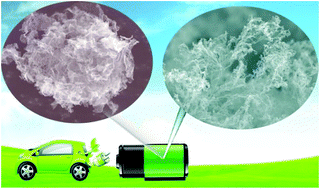Self-assembled and well separated B and N co-doped hierarchical carbon structures as high-capacity, ultra-stable, LIB anode materials†
Abstract
Herein, we present a simple synthesis strategy addressing two challenges of advantageous carbon anode design: (1) achieving self-assembled, i.e. “templateless”, porous hierarchical structures, with (2) well separated B and N co-doping. Heating tert-butylamine borane with two different forms of cobalt catalysts gives rise to either B and N co-doped carbon nanofiber networks (BN-CNN) or B and N co-doped graphene sheet networks (BN-GSN). Both materials form porous, hierarchical networks with advantageous, well separated, B and N co-doping (i.e. with high B–C, N–C or B–C–N content, and very low B–N content). The networks have large surface areas with abundant Li-ion storage sites, high electrical and ion conductivity, and good structural stability. Accordingly, B and N co-doped carbon nanofiber networks deliver an impressively high reversible capacity of 1017 mA h g−1 at 0.05 A g−1 and have ultrahigh long term cycling stability at the high current densities of 0.5 and 2 A g−1, where after 1000 and 2500 cycles, respectively, they deliver 629 and 480 mA h g−1. In addition, B and N co-doped carbon nanofiber networks have a lower average voltage (<1.0 V vs. Li/Li+) and higher first-cycle coulombic efficiency (∼70%) than most reported porous carbons.



 Please wait while we load your content...
Please wait while we load your content...